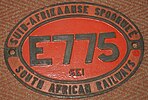| South African Class 5E1, Series 3 | |||||||||||||||||||||||||||||||||||||||||||||||||||||||||||||
|---|---|---|---|---|---|---|---|---|---|---|---|---|---|---|---|---|---|---|---|---|---|---|---|---|---|---|---|---|---|---|---|---|---|---|---|---|---|---|---|---|---|---|---|---|---|---|---|---|---|---|---|---|---|---|---|---|---|---|---|---|---|
 No. E819 waiting to be cut up at Danskraal in Ladysmith, KwaZulu-Natal, 26 April 2007 No. E819 waiting to be cut up at Danskraal in Ladysmith, KwaZulu-Natal, 26 April 2007 | |||||||||||||||||||||||||||||||||||||||||||||||||||||||||||||
| |||||||||||||||||||||||||||||||||||||||||||||||||||||||||||||
| |||||||||||||||||||||||||||||||||||||||||||||||||||||||||||||
| |||||||||||||||||||||||||||||||||||||||||||||||||||||||||||||
| |||||||||||||||||||||||||||||||||||||||||||||||||||||||||||||
The South African Railways Class 5E1, Series 3 of 1964 was an electric locomotive.
In 1964 and 1965, the South African Railways placed one hundred Class 5E1, Series 3 electric locomotives with a Bo-Bo wheel arrangement in mainline service.
Manufacturer
Series 3 of the Metropolitan-Vickers (Metrovick) designed 3 kV DC Class 5E1 electric locomotive was built for the South African Railways (SAR) in 1964 by Union Carriage & Wagon (UCW) in Nigel, with the electrical equipment being supplied by Associated Electrical Industries (AEI).
The Series 3 locomotives were delivered in 1964 and 1965, numbered in the range from E721 to E820. They were equipped with four AEI 281 AZX axle-hung traction motors fitted with tapered roller bearings. UCW did not allocate builder's numbers to the locomotives it built for the SAR and used the SAR unit numbers for their record keeping.
Identifying features

The locomotive had two cut-outs on the roofline on the roof access ladder side, but an unbroken roofline on the opposite side. The Series 3, 4 and 5 locomotives could be visually distinguished from earlier series by their three small square access panels on the lower sides above the battery box instead of the two larger rectangular access panels on the Series 1 and 2 locomotives. Like the Series 2, the Series 3 also had an additional rectangular access panel on the lower sides above the second axle from the left.
Traction motor bearings
Like the Series 2, the traction motors of the Series 3 were also equipped with roller-type suspension bearings. On the Series 2 locomotives the arrangement consisted of a self-aligning ball bearing at the pinion end and a parallel roller bearing at the commutator end of the traction motor. The bearings were grease-lubricated and were carried in a split cannon box to which the traction motor was attached by means of two clamps that engaged cylindrically-machined seatings on the outside of the housing. The roller-type suspension bearings required little attention other than the replenishment of the grease when the wheels were removed for tyre-turning.
When orders were placed for the Series 3 and later models, the specifications made provision for roller suspension bearings incorporating a lip-type cylindrical roller bearing to replace the self-aligning ball bearing at the pinion end, and alternatively for tapered roller bearings at both ends. Since the external dimensions of the bearing-housings would remain the same, the traction motors were still freely interchangeable.
Headlamps
In the 1970s most serving SAR steam and electric locomotives had their original large round headlamps replaced by less attractive but more efficient double sealed-beam automobile headlamps. On Series 3, 4 and 5 units, the original round headlamp housing was retained and the glass was replaced by a metal disk containing the sealed beam headlamps.
Service
The Class 5E1 family served on all 3 kV DC electrified mainlines country-wide for almost forty years. They worked the vacuum-braked goods and mainline passenger trains over the lines radiating south, west and north of Durban almost exclusively until the mid-1970s and Class 6E1s only became regular motive power in Natal when air-braked car trains began running between Durban and the Reef. By the early 2000s the Series 3 locomotives were all withdrawn. None are known to have survived.
Livery
The whole series was delivered in the Gulf Red livery with signal red cowcatchers, yellow whiskers, full body-length side-stripes and with the number plates on the sides enclosed in three-stripe wings. In the 1970s the side-stripes were curtailed to just beyond the cab-sides, but with the number plates on the sides still enclosed in three-stripe wings.
Illustration
-
 No. E742 being cut up at Danskraal, Ladysmith, 26 April 2007
No. E742 being cut up at Danskraal, Ladysmith, 26 April 2007
References
- ^ South African Railways Index and Diagrams Electric and Diesel Locomotives, 610mm and 1065mm Gauges, Ref LXD 14/1/100/20, 28 January 1975, as amended
- "UCW - Electric locomotives" (PDF). The UCW Partnership. Archived from the original (PDF) on 12 October 2007. Retrieved 30 September 2010.
- ^ Middleton, John N. (2002). Railways of Southern Africa Locomotive Guide - 2002 (as amended by Combined Amendment List 4, January 2009) (2nd, Dec 2002 ed.). Herts, England: Beyer-Garratt Publications. pp. 50–51, 53.
- ^ SAR&H Annual Report 1963-64, Research - Mechanical engineering. p. 73.
- Soul of A Railway, System 6, Part 3: Durban Harbour, Wests, the Bluff & Cato Creek to Congella; featuring SAR & H Harbour Craft. Captions 97, 98. (Accessed on 11 March 2017)
- Soul of A Railway, System 7, Western Transvaal, based in Johannesburg, Part 9. South-Eastwards as far as Volksrust (2nd part) by Les Pivnic. Caption 4. (Accessed on 11 April 2017)